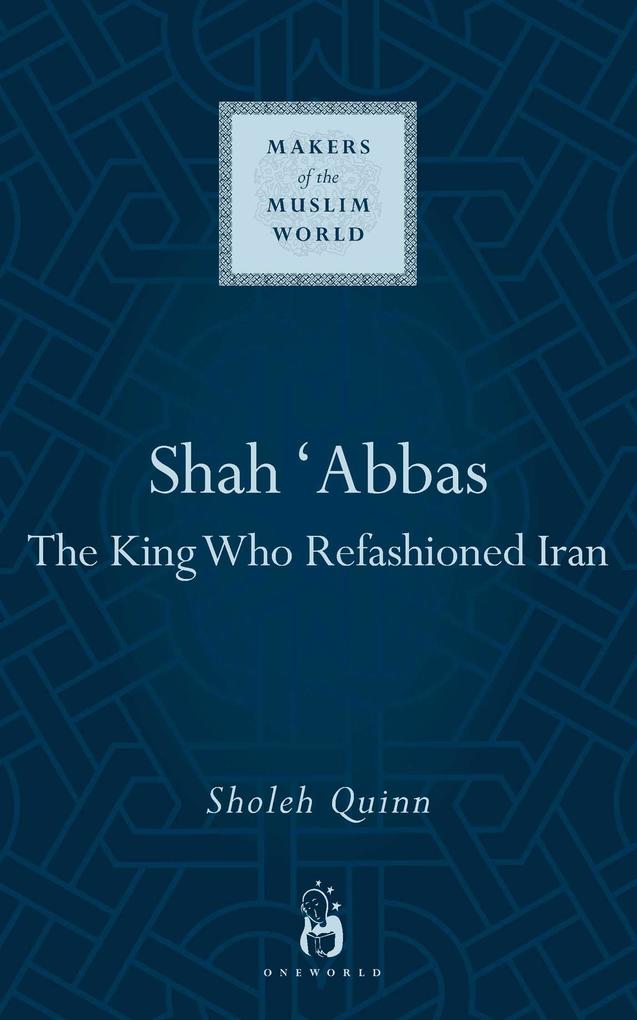
Zustellung: Mo, 26.05. - Mo, 02.06.
Versand in 3-4 Wochen
VersandkostenfreiA new biography of the life of Shah Abbas - generally considered the greatest ruler of the Safavid dynasty in Iran
SHAH ?ABBAS (1571 1629) is the most well-known king of Iran s Safavid dynasty (1501 1722), ruling at the height of its power and prestige. When Shah Abbas came to power his country was in chaos. Yet within eleven years he had regained territory lost to his enemies, moved his capital city and begun a transformation of Iranian society. Few aspects of life were unaffected by his policies and the new capital he built, the spectacular Isfahan, is still referred to as nisf-i jahan, or half the world , by Iranians today.
In this wide-ranging profile, Sholeh A. Quinn explores Shah ?Abbas s rise to power and his subsequent interactions with religious movements and artistic developments, reaching beyond the historical narrative to assess the true impact of the man and his politics. Thought provoking and comprehensive, this account is ideal for readers interested in uncovering the life and thoughts of a man who ruled during a period described by many as a golden age for the arts in Iran.
In this wide-ranging profile, Sholeh A. Quinn explores Shah ?Abbas s rise to power and his subsequent interactions with religious movements and artistic developments, reaching beyond the historical narrative to assess the true impact of the man and his politics. Thought provoking and comprehensive, this account is ideal for readers interested in uncovering the life and thoughts of a man who ruled during a period described by many as a golden age for the arts in Iran.
Inhaltsverzeichnis
Acknowledgements
Preface
Abbreviations
1 HISTORICAL BACKGROUND
The Safavids: the Sufi Order
From Sufi Order to Ruling Dynasty
After Isma‘ il
Qizilbash Culture and Society
Imposing Shi‘ ism
Early Notions of Legitimacy, Power, and Authority
Iran and the World: a Brief Overview
2 EARLY YEARS: 1571– 1598
The Immediate Context: The Reigns of Shah Isma‘ il II and Muhammad Khudabanda
The Birth of Shah ‘ Abbas
First Attempts to Place ‘ Abbas Mirza on the Throne
‘ Abbas Mirza’ s Second Enthronement
Shah ‘ Abbas in Power
Shah ‘ Abbas and the Qizilbash
External Challenges: the Ottoman Truce
External Challenges: Relations with the Mughals
Gilan and Mazandaran
The New Ghulam Army
Shah ‘ Abbas and the Sufi Orders
Suppression of Religious Heresies: the Nuqtavis
Shah ‘ Abbas’ s Temporary Dethronement
Shah ‘ Abbas and Political Legitimacy
Shah ‘ Abbas as “ The Supreme Lord of the Auspicious Conjunction”
3 BUILDING HALF THE WORLD: 1598– 1612
The Image of the World Square
The King’ s Palace
The Royal Mosque
The Shaykh Lutf Allah Mosque
The Royal Bazaar
Endowments
Social Transformations: the Armenians and New Julfa
Social Transformations: the Safavid Household in Isfahan
General Economic Policies and Measures
Shah ‘ Abbas in Isfahan
4 RELIGION AND POWER IN ISFAHAN
The Pilgrimage on Foot to Mashhad
Shah ‘ Abbas and the ‘ Amili Clergy
Systematizing Orthodox Shi‘ ism: Shaykh Baha’ i
The Friday Prayer Controversy
The School of Isfahan
Shah ‘ Abbas and Christianity
Religion and Kingship
5 FROM HALF THE WORLD TO THE OTHER HALF: WARFARE AND DIPLOMACY
Firearms
The Battle for Khurasan: Shah ‘ Abbas and the Uzbeks
Narrating the Campaign
The Battle against the Uzbeks
Shah ‘ Abbas’ s European Diplomacy
The Anti-Ottoman Alliance
Diverting the Flow of Silk
Travelers to the Shah
The Western Front: Shah ‘ Abbas and the Ottomans
6 THE ARTS IN THE SERVICE OF KINGSHIP
New Artistic Styles
A New Visual Identity
Calligraphers and Painters
Sadiqi Beg Afshar
‘ Ali Riza ‘ Abbasi
Mir ‘ Imad
Riza-yi ‘ Abbasi
The Arts in Diplomacy and Gift-Giving
The Embassy of Khan ‘ Alam
The Pierport Morgan Picture Bible
Internal Gift-Giving
7 THE FINAL PHASE: 1612– 1629
Ashraf and Farahabad
Campaigns to Georgia
The Royal Export Silk Monopoly
Victory in Hormuz
The Taking of Qandahar
The Taking of Baghdad
Succession to the Throne
Shah ‘ Abbas’ s Death
Succession and Funeral
Conclusions
Further Reading
Bibliography
Index
Preface
Abbreviations
1 HISTORICAL BACKGROUND
The Safavids: the Sufi Order
From Sufi Order to Ruling Dynasty
After Isma‘ il
Qizilbash Culture and Society
Imposing Shi‘ ism
Early Notions of Legitimacy, Power, and Authority
Iran and the World: a Brief Overview
2 EARLY YEARS: 1571– 1598
The Immediate Context: The Reigns of Shah Isma‘ il II and Muhammad Khudabanda
The Birth of Shah ‘ Abbas
First Attempts to Place ‘ Abbas Mirza on the Throne
‘ Abbas Mirza’ s Second Enthronement
Shah ‘ Abbas in Power
Shah ‘ Abbas and the Qizilbash
External Challenges: the Ottoman Truce
External Challenges: Relations with the Mughals
Gilan and Mazandaran
The New Ghulam Army
Shah ‘ Abbas and the Sufi Orders
Suppression of Religious Heresies: the Nuqtavis
Shah ‘ Abbas’ s Temporary Dethronement
Shah ‘ Abbas and Political Legitimacy
Shah ‘ Abbas as “ The Supreme Lord of the Auspicious Conjunction”
3 BUILDING HALF THE WORLD: 1598– 1612
The Image of the World Square
The King’ s Palace
The Royal Mosque
The Shaykh Lutf Allah Mosque
The Royal Bazaar
Endowments
Social Transformations: the Armenians and New Julfa
Social Transformations: the Safavid Household in Isfahan
General Economic Policies and Measures
Shah ‘ Abbas in Isfahan
4 RELIGION AND POWER IN ISFAHAN
The Pilgrimage on Foot to Mashhad
Shah ‘ Abbas and the ‘ Amili Clergy
Systematizing Orthodox Shi‘ ism: Shaykh Baha’ i
The Friday Prayer Controversy
The School of Isfahan
Shah ‘ Abbas and Christianity
Religion and Kingship
5 FROM HALF THE WORLD TO THE OTHER HALF: WARFARE AND DIPLOMACY
Firearms
The Battle for Khurasan: Shah ‘ Abbas and the Uzbeks
Narrating the Campaign
The Battle against the Uzbeks
Shah ‘ Abbas’ s European Diplomacy
The Anti-Ottoman Alliance
Diverting the Flow of Silk
Travelers to the Shah
The Western Front: Shah ‘ Abbas and the Ottomans
6 THE ARTS IN THE SERVICE OF KINGSHIP
New Artistic Styles
A New Visual Identity
Calligraphers and Painters
Sadiqi Beg Afshar
‘ Ali Riza ‘ Abbasi
Mir ‘ Imad
Riza-yi ‘ Abbasi
The Arts in Diplomacy and Gift-Giving
The Embassy of Khan ‘ Alam
The Pierport Morgan Picture Bible
Internal Gift-Giving
7 THE FINAL PHASE: 1612– 1629
Ashraf and Farahabad
Campaigns to Georgia
The Royal Export Silk Monopoly
Victory in Hormuz
The Taking of Qandahar
The Taking of Baghdad
Succession to the Throne
Shah ‘ Abbas’ s Death
Succession and Funeral
Conclusions
Further Reading
Bibliography
Index
Produktdetails
Erscheinungsdatum
01. September 2015
Sprache
englisch
Seitenanzahl
160
Autor/Autorin
Sholeh Quinn
Verlag/Hersteller
Produktart
gebunden
Gewicht
305 g
Größe (L/B/H)
223/139/20 mm
ISBN
9781851684250
Bewertungen
0 Bewertungen
Es wurden noch keine Bewertungen abgegeben. Schreiben Sie die erste Bewertung zu "Shah Abbas" und helfen Sie damit anderen bei der Kaufentscheidung.







